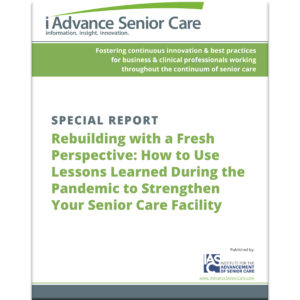COVID-19 Outbreaks Still a Threat for Senior Care Communities
The past few years have been trying for the senior care industry, although COVID-19 vaccinations and testing advancements have helped create a sense of semi-normalcy. Senior care communities are able to resume social activities and visitation though plenty of pandemic precautions remained in place.

Leilani Valdes, MD, MBA, FCAP, a pathologist at Regional Pathology Associates
But it’s easy to get caught up in those feelings of safety and progress, and as we enter the winter, COVID-19 still remains a threat for senior care communities. The Limecrest Subacute and Rehabilitation Center in Andover Township, New Jersey, experienced a COVID-19 outbreak beginning in September. Sixty-six residents and staff members tested positive between September and November, and seven residents died of COVID-19, prompting the state Department of Health to halt admissions at the 159-bed community and require the owners to hire a consultant to run it.
The situation highlights the fact that COVID-19 is still a threat, and it can quickly spread through senior care communities. I Advance Senior Care spoke with Leilani Valdes, MD, MBA, FCAP, a pathologist at Regional Pathology Associates to better understand the COVID-19 threat and whether we could see resurgences this winter.
Why COVID-19 Remains a Threat
Even though the majority of a senior care community may be vaccinated, COVID-19 can still spread. “As with the flu, which has been around for a long time, and which we have a seasonal vaccine for, the purpose of the COVID-19 vaccination is to give us some sort of community resistance or immunity to the virus during times when you see an opportunity for spread,” says Dr. Valdes. “It serves to protect those people within our community who don’t have an immune response or who are unvaccinated, either because they’re too young or can’t get vaccinated for another reason, from being unnecessarily exposed.”
The vaccine accomplishes this by helping to protect a person who is exposed. By shortening the illness period in a vaccinated person, the vaccine reduces the chances of that person transmitting the infection to someone who is unvaccinated. “Having a community that’s mostly vaccinated helps to control the spread,” explains Dr. Valdes. “It also tends to prevent a severe infection, as well as decreasing the possibility of mortality.”
How to Best Protect Residents During the Winter
During the winter, people spend more time indoors and are closer together, especially in cooler climates. “Seasonal viruses often take advantage of the close proximity of patients to spread,” she says. The shift to spending more time indoors increases the chance of a surge in COVID-19, RSV, and the flu during the winter.
Protecting senior care community residents starts with ensuring that most of the population is vaccinated. “As we age, our ability to mount an immune response to a vaccine is lowered,” says Dr. Valdes. “If you have more of the population vaccinated, it will help offset the fact that your population is older. It’s especially important to convince staff and family residents to be vaccinated to prevent that spread.”
Senior care communities can also focus on good health hygiene to help prevent the virus’s spread. That includes frequent handwashing, covering your face and nose when you sneeze, and making sure that if you touch a surface, you wash your hands before touching your face.
Having a plan for when staff need to call out sick is also important. “Make sure the facility has a mechanism set up so they individuals and staff caring for patients don’t feel the need to come to work sick,” Dr. Valdes recommends. “The best thing we can do when we’re not feeling well is to stay home to protect coworkers and residents.”
She also highlights the importance of ongoing testing in relation to seasonal viral illnesses. “One of the advantages of going through a pandemic is our understanding of testing for different viruses and how important that can be,” she says. Dr. Valdes notes that testing is particularly important for viruses for which a treatment is available. “We don’t necessarily think that all patients need testing, and as long as you are not exposing other people when you’re not feeling well and stay home, you might not need testing. But if you’ll be interacting with a vulnerable population, there’s a need for testing to make sure you’re not spreading the virus to a vulnerable population.”
Addressing Vaccination Reluctance
If enough people choose to forego the COVID-19 vaccine boosters, we could see a resurgence of COVID-19. “We’ve actually seen that in diseases like the Measles,” explains Dr. Valdes. “We lowered the vax rates and saw a resurgence of that within our communities.”
If enough people don’t stick with a vaccination schedule or skip getting the booster for a year, that can give the virus an opportunity to spread. “When you have fewer people who mount a really high immune response, they’re going to feel unwell and have symptoms for a longer period of time,” Dr. Valdes notes. “There’s a higher likelihood of spreading the virus to other people. Immunocompromised people, even when they’re vaccinated, may not have the same response that those who are well would. It’s a real risk to our most vulnerable communities.”
As the pandemic has stretched on for years, communities may encounter reluctance from staff, residents, and family members when it comes to staying current on vaccinations. “Vaccinations are very safe, and they have allowed us to really get through this pandemic and past flu seasons, reducing the morbidity and mortality rates,” says Dr. Valdes.
At the same time, getting vaccinated is a personal decision. “I often find when I have a personal discussion with the individual considering whether or not to get vaccinated and reserve judgement, answer questions, and provide information, that’s the key to understanding the benefit of being vaccinated.
“I do believe we are all suffering a bit of COVID fatigue,” says Dr. Valdes. “It’s not unlike the fatigue we see every year when it comes to flu. I’m hopeful that in the future, we’ll see the COVID-19, flu, and RSV vaccines will really be part of our annual wellness responsibilities,” she says. “I hope we’ll think of vaccination not so much in terms of a pandemic, but as what we can do every year to protect ourselves, the community, and the ones we love.”

Paige Cerulli is a contributing writer to i Advance Senior Care.
Related Articles
Topics: Featured Articles , Infection control , Risk Management








